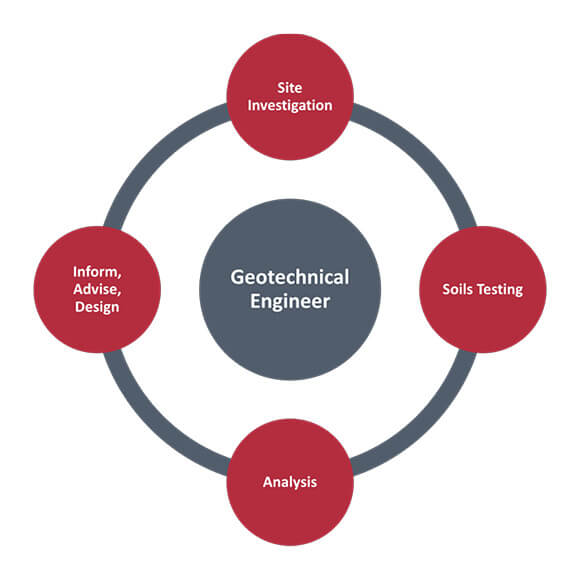Little Known Facts About Geotheta.
Little Known Facts About Geotheta.
Blog Article
7 Simple Techniques For Geotheta
Table of ContentsSome Of GeothetaNot known Factual Statements About Geotheta The 9-Second Trick For GeothetaThe Ultimate Guide To GeothetaWhat Does Geotheta Mean?

They carry out website investigations, collect samples, execute laboratory examinations, and evaluate data to review the viability of the ground for building tasks - Geo Tech Engineering. Based on their searchings for, geotechnical engineers give suggestions for structure layout, incline stability, keeping frameworks, and reduction of geotechnical threats. They work together with other specialists, such as designers, structural designers, and building and construction groups, to ensure that geotechnical factors to consider are incorporated into the total task layout and application
By analyzing the actions and residential properties of dirt and rock, they can recognize possible geotechnical dangers such as landslides, dirt settlement, or incline instability. Their competence helps prevent failures or accidents that might jeopardize lives and residential property. Here are some thorough responsibilities and obligations of a geotechnical designer: Site Investigation: Geotechnical designers conduct site investigations to collect information on subsurface problems.
They interpret the data to comprehend the homes and actions of the soil and rock, including their strength, leaks in the structure, compaction features, and groundwater conditions. Geotechnical Analysis and Style: Geotechnical designers evaluate the data gathered during site examinations to assess the security and viability of the website for building and construction tasks. They carry out geotechnical calculations and modeling to review aspects such as bearing capacity, settlement, incline security, lateral earth stress, and groundwater circulation.
How Geotheta can Save You Time, Stress, and Money.
Structure Layout: Geotechnical designers play a critical role in making foundations that can securely sustain the intended structure. They analyze the dirt problems and lots demands to figure out the ideal foundation kind, such as superficial foundations (e.g., footings), deep structures (e.g (https://ameblo.jp/geotheta/entry-12862281966.html)., heaps), or specialized techniques like dirt improvement. They consider aspects such as negotiation limitations, birthing ability, and soil-structure interaction to develop optimal structure styles
They assess building plans, screen site tasks, and conduct area examinations to validate that the design recommendations are complied with. If unforeseen geotechnical issues occur, they assess the scenario and offer recommendations for remediation or modifications to the layout. Threat Analysis and Mitigation: Geotechnical designers analyze geotechnical threats and risks connected with the job website, such as landslides, liquefaction, or soil disintegration.

Cooperation and Interaction: Geotechnical designers work very closely with other professionals associated with a project, such as architects, structural engineers, and building groups. Efficient communication and collaboration are important to incorporate geotechnical factors to consider into the overall task style and construction procedure. Geotechnical engineers offer technical know-how, solution queries, and make sure that geotechnical demands are fulfilled.
How Geotheta can Save You Time, Stress, and Money.
Below are some sorts of geotechnical designers: Foundation Engineer: Foundation designers specialize in creating and examining foundations for structures. They analyze the soil problems, tons needs, and site attributes to establish one of the most suitable foundation kind and layout, such as shallow structures, deep structures, or specialized techniques like heap foundations.
They examine the aspects affecting incline stability, such as soil properties, groundwater problems, and incline geometry, and establish techniques to avoid slope failures and minimize risks. Earthquake Designer: Quake engineers focus on analyzing and creating structures to endure seismic forces. They examine the seismic hazard of a website, assess dirt liquefaction possibility, and establish seismic layout standards to guarantee the security and strength of frameworks throughout quakes.
They carry out area testing, collect examples, and analyze the gathered data to identify the soil residential properties, geologic developments, and groundwater conditions at a site. Geotechnical Instrumentation Designer: Geotechnical instrumentation designers concentrate on surveillance and gauging the habits of dirt, rock, and structures. They mount and preserve instrumentation systems that monitor elements such as soil settlement, groundwater degrees, slope activities, and architectural displacements to analyze efficiency and give early cautions of prospective concerns.
Some Known Factual Statements About Geotheta
They carry out tests such as triaxial examinations, combination examinations, straight shear tests, and permeability examinations to collect information for geotechnical evaluation and design. Geosynthetics Engineer: Geosynthetics designers specialize in the design and application of geosynthetic materials, such as geotextiles, geogrids, and geomembranes. They use these products to boost soil stability, strengthen inclines, supply drain services, and control erosion.
They tend to be investigative people, which implies they're intellectual, reflective, and investigative. They wonder, methodical, sensible, analytical, and sensible. Several of them are also social, meaning they're kind, generous, cooperative, person, caring, practical, understanding, sensible, and pleasant. Does this seem like you? Take our free occupation examination to locate out if geotechnical designer is among your top occupation suits.
In the workplace setting, geotechnical engineers utilize specialized software program tools to carry out calculations, create designs, and examine data. They prepare reports, testimonial job specs, interact with customers and staff member, and coordinate job tasks. The workplace setting provides a helpful environment for research, evaluation, and collaboration with other experts associated with the project.
Fascination About Geotheta
They frequently go to project websites to perform site examinations, evaluate geotechnical problems, and collect information for analysis. These visits involve taking a trip to different areas, sometimes in remote or tough terrains. Geotechnical designers might perform soil tasting, conduct tests, and monitor building and construction activities to guarantee that the geotechnical aspects of the project are being executed properly.
Geotechnical designers likewise operate in specialized geotechnical research laboratories. In these facilities, they carry out experiments, do tests on soil and rock samples, and examine the engineering homes of the materials. Geotechnical research laboratory engineers work thoroughly in these environments, taking care of testing devices, running instruments, and tape-recording data. They team up with other laboratory team to make sure accurate and trustworthy testing outcomes.
Report this page